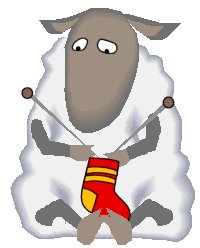HINTS AND TIPS
The workshop covers a vast range of subjects from hobbies,
handicrafts, DIY, plumbing, woodwork etc. There is a separate page which covers the
DIY type of tips, on this page you will find some more useful tips
on other areas:-
Patricia Ellistone
has kindly sent in the following four very useful tips -
- Put mohair in the freezer before knitting up,
it stops it shedding so much.
- If going to machine knit some hairy yarn,
place it in a large plastic bag and spray in some silicone knitting
spray and leave for a day. It will run better through the sinker
plate.
- Invest in a wool winder. Re-wind yarn into a
neat (flat bottomed) ball and pull yarn from the middle. Ball will not
jump about, much easier to knit with.
- Have a look at cross stitch charts for ideas
for filet crochet.
Other uses for recycling denim are skirts, purses,
jean jackets (use those Big Bel/raver pants and a pattern), organizer covers and even
sandals. Cut heel and sole out of wood then use the jeans to make the part over the
bridge of the foot and straps. Cute if not very practical in harsh conditions!
Contributed by Lindsay Prior.
Thanks to Mary Thayer for this suggestion.
When handknitting a garment if you knit sleeves
from shoulder to cuff (by reversing the pattern) this will enable the sleeves to be
lengthened if required. The cast off stitches at the cuff can be taken undone,
stitches picked up on a needle and extra length added with either the same or matching
yarn.
-
Hand knitted socks can be made into
fingerless gloves by cutting at the ankle, oversewing the cut edge to prevent the knitting
unravelling, then joining the two edges between each finger to make holes for each finger
and thumb.
Courtesy of Margaret Reeve
|
 |
- To lengthen dresses, unpick stitching at the waist, knit two
rectangular sections in a matching or contrasting yarn, large enough to fit between the
two side seams and deep enough to lengthen dress to required length (up to a maximum of
about 6"). Then sew the knitted pieces between the skirt top and dress top. If
a rib pattern is used for the knitted section this will hold nicely into the waistline.
- Alternatively, cut across the skirt (a little way up from the hem)
and insert a strip of matching or contrasting material which is wide enough to lengthen
the skirt to the required length, then join back together. As long as the rest of
the garment fits O.K. another strip can be added above the first (i.e. higher up the
skirt) at a later stage.
- To make your own cross stitch or tapestry
charts, choose an
appropriate picture and put this over some graph paper with carbon paper in between,
staple together along the top edge. Trace the outlines, including places where it
changes colour, you can lift the image and carbon paper to see what it looks like.
When this is done, outline the picture parts to its closest square, then add the colours
with coloured pencils or use a different code for each colour making sure you can still
see each square underneath the pattern or colour. Choose yarns to match as closely
as possible, making modifications as and when required. Now start stitching (if you
have time that is).
Thanks to Kim Hedrich
- To lengthen or just for variety, sew a piece of heavy fabric with
a crazy design (i.e. flowers etc.) on the bottom, giving it a 2" - 4"
'facelift'. Sounds 70'ish but I just saw someone wearing a pair that were actually
bought this way - I guess this is coming back into fashion in 2000.
Thank you Denise.
When using
pins, do not put them in your mouth as
this is not only very dangerous but can also mark fabric. Sew a pin cushion onto an
elasticated wrist band and use that.
If you need to remove a
pencil mark from
embroidery (or indeed from any fabric), take a small piece of dough from a loaf of white
bread, knead with fingers and then rub gently over the pencil mark, which should
disappear.
To prevent
embroidery thread becoming tangled in
the skein, remove wrapper, and plait (or braid) the threads. Threads can be removed
by pulling from bottom without becoming tangled.
Always use thread the same way as it comes off the
spool - if used the wrong way it snags.
 |
|
- Put clear nail varnish on ribbon ends to keep them neat and prevent them from fraying.
- To change the colour of shoes, handbags etc. use artists' acrylic paint. These can
be used to change the colour completely or, alternatively, to add a design.
- When removing buttons from clothing, place a comb between the button and the fabric
before snipping the threads. This will prevent any damage to the material.
Now two from Nick's
mum -
-
Long
trousers for boys – when they grow out of them they can be cut down and
turned into short trousers.
-
Shirt
cuffs- when they become worn they can be turned inside out – and then re
stitched. They then look like new!
Nick Wareham
Copyright © 2000-2020
Hints and Things
All Rights Reserved.
No portion of this site may be reproduced or redistributed
without prior written permission from Hints and Things. All
trademarks & copyrights throughout Hints and Things remain the
property of their respective owners.
Hints and Things
cannot be held responsible for any information given on this
site nor do they necessarily agree with, or endorse, the views
given by third parties.
|

